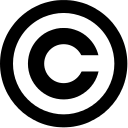Visit: Our hours
Schedule an Appointment
Get Research Help from a Librarian
Call:
Brighton: 585-292-2303
Downtown: 585-685-6005
Email:
libraries@monroecc.edu
Here you will find general information regarding copyright as listed in the United States Code. The works that can have copyrights applied to them are listed in Section 102 as well. While the author/creator no longer is required to register copyright or have the copyright notice be added to their works, it is sometimes beneficial if they do.
More information can also be found on the U.S. Copyright Office's website.
This guide is intended to provide information and resources for utilizing materials protected by copyright as well as to assist educators in navigating the process of properly using copyright protected resources, including fair use, gaining permission, etc.
This guide also includes information for creators of works, including how to copyright your own materials, how to learn more about using Creative Commons in an effort to contribute to the sharing and development of creative works, and more.
United States Code Title 17, Section 102: Subject matter of copyright: in general
(a) - Copyright protection subsists, in accordance with this title, in original works of authorship fixed in any tangible medium of expression, now known or later developed, from which they can be perceived, reproduced, or otherwise communicated, either directly or with the aid of a machine or device. Works of authorship include the following categories:
(b) In no case does copyright protection for an original work of authorship extend to any idea, procedure, process, system, method of operation, concept, principle, or discovery, regardless of the form in which it is described, explained, illustrated, or embodied in such work.
Copyright is defined as "the exclusive legal right, given to an originator or an assignee to print, publish, perform, film, or record literary, artistic, or musical material, and to authorize others to do the same."

Or, as the U.S. Government defines it, as:
A form of protection provided by the laws of the United States for "original works of authorship," including literary, dramatic, musical, architectural, cartographic, choreographic, pantomimic, pictorial, graphic, sculptural, and audiovisual creations. "Copyright" literally means the right to copy but has come to mean that body of exclusive rights granted by law to copyright owners for protection of their work. Copyright protection does not extend to any idea, procedure, process, system, title, principle, or discovery. Similarly, names, titles, short phrases, slogans, familiar symbols, mere variations of typographic ornamentation, lettering, coloring, and listings of contents or ingredients are not subject to copyright.
Check out this Copyright Basics Circular.
Accessibility is important to us. While we have made efforts to make our guides as accessible as possible, it is possible that issues could be present. If you are having difficulty accessing content in these guides or if you have any questions about the accessibility of online information posted by the MCC Libraries, please contact us.